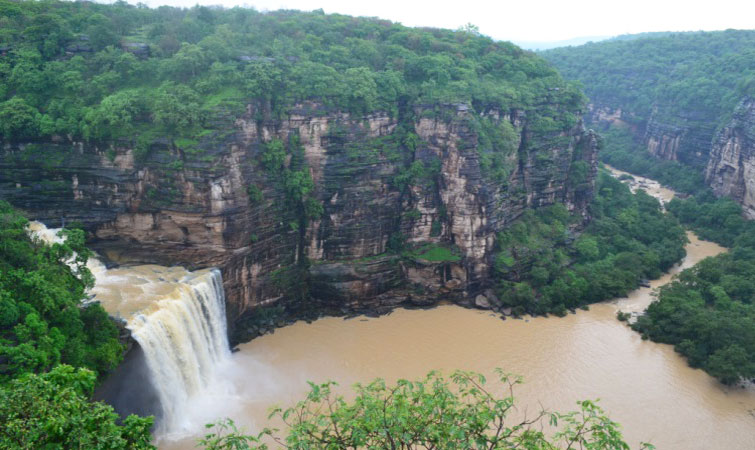Chandraprabha Wildlife Sanctuary located near Varanasi has some stunning waterfalls. Their natural beauty mesmerizes everyone. Chandraprabha Wildlife Sanctuary article covers topics like Pictures, Timings, Distance, Location, What To Do, How To reach, etc.
About ChandraPrabha Wildlife Sanctuary
The ChandraPrabha Wildlife Sanctuary (also known as Chandraprabha) is located in the eastern region of Uttar Pradesh. It is very popular with beautiful picnic spots, dense forests and picturesque waterfalls like Rajdari and Devdari that attract tourists every year nearby. The ChandraPrabha Wildlife Sanctuary is located about 70 kilometers from the basking town of Varanasi.
Flora and Fauna
The sanctuary has an area of 78 square kilometres. The sanctuary lies within the Lower Gangetic Plains moist deciduous forests ecoregion.
Plant communities include esert thorn forest and scrub, dry tropical riverine forest, dry deciduous scrub and savanna, southern dry mixed decidous forest, alluvial savanna forest. The habitat is a paradise for ornithologists and birdwatchers. It is a home to around 150 species of birds. The wild plants present in the sanctuary are tendu, ber, koriaya, mahua, amaltas, saagun besides several medicinal plants.
A variety of wildlife can be seen in Chandraprabha WLS. These include blackbucks, chital, Indian gazelle, sambhar, nilgai, porcupine, wild boar, etc. Reptilian species include gharial and python.
Interesting Facts
ChandraPrabha Wildlife Sanctuary, once a habitat of Asian lions, has all the natural ingredients to become a beautiful tourist / picnic spot. It has beautiful picnic lifestyles, dense forests and picturesque waterfalls like Raj Dari & Dev Dari and a dam near the ChandraPrabha dam. The wildlife sanctuary was established in 1957 and covers an area of 9,600 hectares. The central area of the Sanctuary covers more than 2,686 hectares, while the buffer zone covers 66,000 hectares, including the Kashi Wildlife Division.
It was the habitat of the Asian Lion from 1957 to 1970, but after the lions disappeared from here. In the past, the naxal problem was not there, people used to move here and enjoy wildlife, forest and natural beauty during the winter season, and also during the rainy season when Waterfalls have added a greater attraction to the lush green environment of the sanctuary. It serves as a natural and ideal habitat with its meadows, numerous caves in the Vindhyan area and waterfalls for a host of animals and plants (medicinal) and has great potential to develop Jungle Tourism in the sanctuary where people Can enjoy the natural beauty and bio-diversity.
The animals found here are Leopard, Chausingha, Black Buck, Chital, Sambhar, Rabbit, Nilgai (Blue Bull), Wild Boar, Porcupine, Wild Fox Indian Gazelle, Monkey, Chinkara, Hyena, Wild Cat, Jackal and others. Besides this, there is a wide variety of colorful birds and crawling animals (toxic and non-toxic) in the sanctuary. The rivers ChandraPrabha and Karmnasha, which cross the sanctuary, have a variety of fish. A remarkable growth of the population of some beasts like Leopards & Boars was observed.
Places of interest in the sanctuary
Raj Dari
It is the largest waterfall in this region because its height is over 65 meters and the amount of water that falls is enormous. The best time to visit is from September to March. Winter and spring are the best. It is in the middle of the Chandraprabha Wildlife Reserve. There is a dam about 1 km before and thus forms a reservoir of water that feeds the waterfall. The name of the dam is also Chandraprabha Dam and the forest is also called Chandraprabha.
The crystal clear waters, gurgling on the rocks present a breathtaking sight. The picturesque and tranquil surroundings give a sense of mysticism to the experience. People usually come here for a day trip and although there is no accommodation here, there are several restaurants here to serve drinks and snacks.
Dev Dari –
It is about 500 meters in the lower stream to the Raj Dari waterfall. This is also a very beautiful scenic spot.
ChandraPrabha Dam :
This tourist attraction is located upstream on the ChandraPrabha River near the sanctuary and is the source of water for both waterfalls. The dam called ChandraPrabha was built by the Department of Irrigation.
A Nature Interpretation Center, showing the names of different species, a library and resource center, a small canteen and a guest house office ( Ramnagar) with 7 suites available at Rs. 100- 300, are located inside the sanctuary, near the Raj Dari waterfall.
Measures To Protect ChandraPrabha Wildlife Sanctuary
The wildlife sanctuary of ChandraPrabha is located in the Chandauli district of Uttar Pradesh and is part of the Kashi Wild Life division. In order to combat organic and human pressure on wildlife, in the form of human encroachment and industrial expansion, combined with an increase in population. In 1957, a total area of 9600 hectares was allocated as a forest area and developed as a sanctuary of wildlife Chandra Prabha. An additional buffer zone of 66,000 hectares was also reserved as forest land under the central area of the Kashi Forest Division. This buffer zone guarantees the central area as well as the area of the Wild Sanctuary ChandraPrabha from the pressure of human encroachment and industrial expansion.
ChandraPrabha The Sanctuary of Wildlife is a model sanctuary, natural-accustomed to wildlife found locally or migratory in the area. A number of grassy lands, caves and waterfalls in the Vindhyachal range punctuate the landscape. The sanctuary was found to mitigate the constantly decreasing population of the Asian Lion and to give a boost to the conservation of the Lion, a male lion named Raja and two women, namely Rani and Jayshree, were brought here from the Gir Wild Life Sanctuary, Gujarat in 1957. Although the lions actively roamed the area until 1970, but due to the high biotic pressure, the efforts failed.
Location of ChandraPrabha Wildlife Sanctuary
The sanctuary is located in the district of Chandauli, in the south-east of U.P., between Chakia and Naugarh.
Varanasi to Chandra Prabha wildlife sanctuary distance: 70 KM
Best Time to Visit Chandra Prabha Wildlife Sanctuary
The best time to visit Chandra Prabha Wildlife Sanctuary is from July to February, but the sanctuary is at its best during and after the rainy season.
Timings: from 6 am to 5 pm, open every day
Activities:
Nature and wildlife
Birding
Forest
Scenic waterfalls – Rajdari/Devdari
Wildlife
Picnic spot
Admission fees
Rs. 30 for Indian citizens, Rs. 350 for foreigners, Vehicle Parking @ Rs. 10 for two wheeler, Rs. 50 for four wheeler, Rs 100 for heavy vehicles, Movie-camera charges – Rs. 7000 for foreigners.
Parking fee: Rs. 50 for Car & Rs. 100 for Bus
How to reach ChandraPrabha Wildlife Sanctuary
It is accessible by road and you can easily reach by bus / taxi from city Varanasi, which is 70 km via Varanasi-Mughalsarai-Chakia-Naugarh and 70 km via the Varanasi-Pandav-Ramnagar-Mughalsarai-Chakia-Naugarh road. Varanasi Railway Station is 70 kms away and Mughalsarai Station is 55 kms away while Babatpur Airport, Varanasi is 90 kms away.
Chandra Prabha wildlife sanctuary hotels:
We have listed some of the hotels nearby the sanctuary.
GenX Plaza Mughalsarai, Varanasi, India
G T Road, , Opposite Subhash Park, Dist. Chandauli,
Varanasi, Uttar Pradesh, 232101, India
3-star Varanasi hotel with restaurant
Free WiFi and free parking
Hotel Grapevine, Varanasi, India
Katesar Ramnagar Varanasi, Varanasi, Uttar Pradesh, 221008, India
4-star hotel in Varanasi with restaurant, bar/lounge
Free buffet breakfast, free WiFi, and free parking
Rahul Guest House, Varanasi, India
N1/15 D-10 Gangotri Vihar, Nagwa, Lanka, ( Near – Ravidas Park ),
Varanasi, Uttar Pradesh, 221005, India
No-frills Varanasi guesthouse with restaurant
Source: https://www.upecotourism.in

